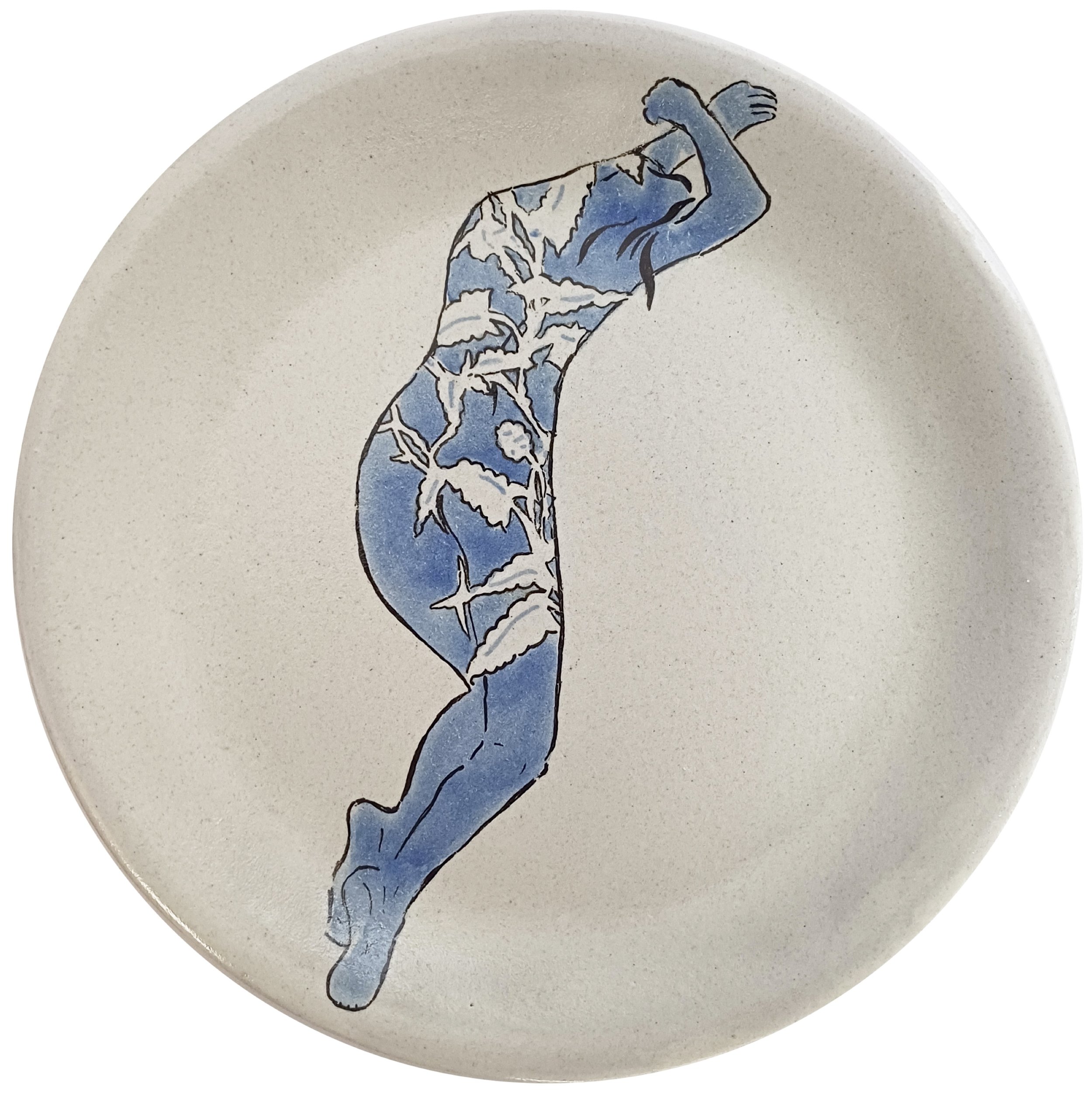Natalia Revilla
Natalia Revilla is an interdisciplinary artist based in Lima. She constructs an amalgam of narratives in which the social sphere and individual imagination intersect with the ambiguities and uncertainties of communication.
Many of her projects investigate the impact of facing the transformation of places and landscapes, due to changes that occur in nature produced by socio-environmental conflicts, natural disasters and also because of human action.
The destruction of these spaces is part of a crisis, not only on a collective scale, but also of the identity of each individual, since it breaks the sense of belonging, being also a silent form of violence in the deep dimension of the intimate.
In these spaces the woman's body has played a fundamental role, since it has been represented as a symbol of the conquered territory.
Shitikagantsi. In Western paradigms, the relationship with nature is mediated by social and political relations, power and hierarchies. Here, nature is symbolically constructed as a resource. Subject-object dualism applies to people the characteristic of subject and to nature that of object, so that despite the fact that the human being is part of nature, it is seen through dualism as outside of it. Thus, it takes for granted that water, land, plants and animals are resources.
The destruction of the forces that regulate life in all its planes of existence and the violent transformation of the territories due to environmental conflicts have altered the coexistence of people with their environment, breaking the sense of belonging, being a silent form of violence in the deep dimension of the intimate.
Given this, language stands as a key piece for the configuration of personal identity and collective history. Words are a vehicle to represent the world, what we use to name our experiences and they tell us about the ways in which we configure reality. Shitikagantsi is a word in Machinguenga, one of the 48 original languages of Peru, which could be translated into Spanish as: "Being connected - plants: roots connected with some part of a tree or connected tissues that sprout”.
This series of drawings arises from this word and leads us to reflect on different types of connections that may exist between different beings, between different bodies and their relationship with nature.
Here, the new tissues can be understood not only as a hybrid, but as a relationship formed / constituted by different natures and different existences that coexist in other territories, which not only exist physically, but are transported within us, from a point of view that states that we are part of nature in antagonism with the one that maintains that we live in it.
Untranslatable. Awajún. Short poems in Awajún, a language used in the department of Amazonas that have no translation into Spanish. Each word is translated based on the sound wave it produces, that is, by its sound graph. In this way, each word contained in the poem is transformed into a universal palette/poetry of sound waves and colors made with natural pigments from the region. They are spoken phrases or songs, associated with feelings and memories that people dedicate to people they miss or to whom they wish well-being.
After that, the reverse process is performed. A word in Spanish will be assigned to each frequency, building a new meaning, but based on the structure of the initial poem, as an intuitive and sensory way of talking about the synesthesia that a word contains, with its sonority and its written form, and also of the translation, which aims to evoke a construction in our thought, but which is difficult for us to recognize when it is encrypted in another language.
This creates landscapes associated with this language in the regions surrounding the Marañon River in the department of Amazonas in Peru.
Continuing with the "untranslatable" project, that is, on the non-existence of equivalences between words in different languages, interviews will be conducted with Awajún, Shawi, and Quechua lamista women. The results of these interviews will be drawings of those words that cannot be translated into Spanish, but that are linked to their experience as women within their emotional environment, community, political participation, etc.
BIO Natalia Revilla (Perú, 1981)
She is Visual artist graduated with a specialty in painting from the Pontifical Catholic University of Perú.
She has held individual exhibitions in Lima and Buenos Aires and has participated in various group exhibitions such as “Emerging Voices”, Art Collection of the Inter-American Development Bank (Washington DC, USA); “Rivers can exist without water but not without banks”, Museum of Contemporary Art (Lima, Perú), “Paper Routes - Women to Watch 2020”, National Museum of Women in the Arts (Washington DC, USA); “Witches: The Tribe”, RoFa Projects (Gaithersburg, USA); “Present Time”,“Contemporary Peruvian Art”, Kiosco Gallery (Bolivia); “What if democracy happens?”, Galería 80m2 (Lima, Perú). As well as at the International Art Fairs Arco Madrid, Zona Maco, ArteBa, Estampa Madrid, Pinta London, Swab Barcelona, among others.
Her work is in the collections of the Inter-American Development Bank (IDB), Lima Art Museum MALI, and the Florean Museum Romania.
Her work has been published in "Amazonistas" (Editor: Cristian Bendayán, Bufeo Amazonía); Colección Encuentros Cercanos: "El Porvenir es el pasado que viene", Libro de artista (Editors: Miguel López, Nancy la Rosa, Juan Salas); Art Nexus, Nro. 92 "The invisible is a place" (Miguel López); "What if democracy happens?" (Editors: Miguel López and Eliana Otta); "Pleasure is more important than victory" (Miguel López and Sharon Lerner), among others.
She is Co-Director of Contexto, a Publisher of Artist Books and has curated editorial projects for the Atenas Art Book Fair 2022 and 2023. She has participated as a Researcher in the Curatorial Team of the Place of Memory LUM in Perú. She is also a member of the groups Altarpieces for Memory, Cooperative Collection and Women in the Visual Arts.
Nuwa Waimaku: The power of words
March 27th - May 24th, 2024 at the Embassy of Peru in Washington DC
Nuwa Waimaku: The power of words In the Murui-Buue, Matsigenka, Ese Eja and Awajún communities, women's leadership committed to promoting education, women's empowerment, protection of victims of sexual abuse and pride in their identity are strengthened.
The words Awajun Nuwa Waimaku translate as visionary woman in English, but in reality it is something with much more vital meaning. It means "those who have found the way" and have the strength to achieve what they set out to do. The story of each Nuwa Waimaku tells their fight against the dispossession of their territory and the care of their family in the Amazon.
Natalia has found the way. She, the hereditary, the ancestral, knows the languages, the potions, the healing power of plants and seeds. This is what her sisters and aunts have taught her and she knows well the importance of preserving them. There are 48 native languages of Peru on the verge of extinction and she tells us about their power. Of the power of the word.
Revilla explores epistemicide and the ambiguities, uncertainties and gaps in communication when studying the indigenous people of Peru. Natalia is concerned with Western paradigms where interaction with nature is mediated by social and political relations, power and hierarchies.
The life of communities have been organized in the world based on words. Human beings have marveled at them, resisted in their memories and spread their stories. From the daily murmuring of a river, to prejudices and a whole constellation of astonishments have been held captive in them, giving meaning to them.
Each language collects the history of its people by weaving together experiences inherited by successive generations in their oral and written traditions. Thus, the word is the link in a chain, which all human production uses and participates in to complete its creations. Each language is evidence of a community spirit, a reflection of a particular way of living in the world.
Revilla carves, draws and sculpts the encounter between different languages. It is there where she shows us unique words that dissolve any possibility of reference in the world of our spoken experience. And suddenly and without further reference we find wisdom in them, what Walter Benjamin called “the epic side of the truth”, and for us it is also the power and role of the word.
This is the poetry of Natalia Revilla's images and her language is the image, which becomes words.
Gabriela Rosso
Burnt. Series of drawings from two groups of images: Photographs of some periods of political tension in Peru, and photographs of family albums. The technique used poses an allegory to the drawn image and in contrast, the hole and the ashes turn vacuum into something physical.
Twenty words Communities have been constructed throughout this world from words. With them they have marveled, resisted in their memories and spread their stories. From the most futile everyday experience like the cyclic murmuring of a river, a constellation of people have been captivated by them, giving them meaning.
Each language collects the history of its people by weaving experiences, that are inherited by successive generations in their oral and written traditions. Thus, the word is the link of a chain, from which all human production serves itslef and participates to complete its creations. Each language is the evidence of a community spirit, a reflection of a particular way of living in the world.
Mysteriously, language generates community. Even though it is a field undermined by equivocal ambiguities and interpretations that we see confronted in situations such as the encounter between culturally different languages. That is where unique words emerge that express what for us would be almost a saying (refrain), dissolving any possibility of reference in the world of our spoken experience. Even so, the inability to find an accurate meaning, in our language, does not underestimate the wisdom we find in them. What Walter Benjamin called "the epic side of truth," and which we find in the eloquence of his narrative expressiveness.
That is the question to which these images confront us. From the encounter of a Mtsiguenga - Castellano dictionary and from interviews with speakers of both languages, these 6 words are presented without admitting parity in ours. Here, the word it is disputed between the trap of solving an equivalence and the narrative breadth of the symbolic world that originated them in their conceptions about death, nature and its people.
The other site Tilsa Otta. The places where we live, we carry them with us everywhere, like an empty space. Natalia Revilla reconstructs the landscapes that keep her in motion, those scenarios that permeate our memory and when she revisits them they provoke a reflection, a double phantom: the trail of the past, what was and what we were, settles like the sunset over the present.
The heart accumulates a mileage, and in each space that we occupy, in some way we are still there. We leave impregnated the color of a look, the trace of our steps, vestiges of the transit and the room, ancestral frictions of the coexistence between the human being and his environment. Although sometimes, one of the parties transgresses this pact, breaks protocol and transforms everything.
Suggesting a parallel with the Rorschach test, Natalia psychoanalyzes the landscapes by discovering what lies beneath the unconscious and the soil: so many lives that have passed by leaving the dead, that over time become part of the landscape, decompose and vanish in the unshakable beauty of nature. "The other site" illustrates the subtle dichotomy of Being and Not Being, or of Being and Not being able to preserve a place.



















































